 |
Guidelines for OpenVMS Cluster Configurations
6.5.3 Device Naming Using HSZ Allocation Classes
When any node has multiple buses connecting to the same storage device,
the new HSZ allocation class shown in Figure 6-15 must be used.
Figure 6-15 Devices Named Using an HSZ Allocation Class
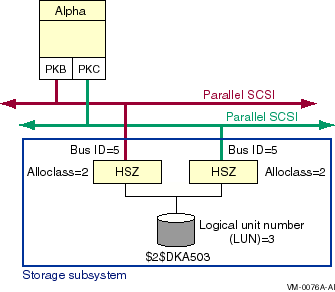
An HSZ allocation class is similar to the HSC, HSD, and HSJ allocation
classes. The device name, using an HSZ allocation class number, takes
the following form:
$HSZ-allocation-class$ddcu
|
where:
- HSZ-allocation-class is a decimal value from 1 to 999,
assigned to a particular HSZ storage controller by the system manager
- dd represents the device class, which is DK for disk
- c represents the controller, which must be A when using an
HSZ allocation class
- u represents the device unit number, which is determined
by the SCSI bus ID and the logical unit number (LUN) of the device
The system manager sets an HSZ allocation class from the HSZ console,
using one of the following commands, as appropriate to the
configuration:
HSZ> SET THIS_CONTROLLER ALLOCATION_CLASS = n
|
or
HSZ> SET OTHER_CONTROLLER ALLOCATION_CLASS = n
|
where n is a value from 1 to 999.
When the allocation class is set on one controller module in a dual
redundant configuration, it is automatically set to the same value on
the other controller.
In the following example, the allocation class is set to 199. The
example shows that the value is set for both controllers.
z70_B => SET THIS ALLOCATION_CLASS=199
z70_B => SHOW THIS_CONTROLLER
Controller:
HSZ70 ZG64100136 Firmware XB32-0, Hardware CX25
Configured for MULTIBUS_FAILOVER with ZG64100160
In dual-redundant configuration
Device Port SCSI address 6
Time: NOT SET
Host port:
SCSI target(s) (0, 2, 3, 4, 5, 6)
TRANSFER_RATE_REQUESTED = 20MHZ
Host Functionality Mode = A
Allocation class 199
Command Console LUN is target 0, lun 1
Cache:
32 megabyte write cache, version 4
Cache is GOOD
Battery is GOOD
No unflushed data in cache
CACHE_FLUSH_TIMER = DEFAULT (10 seconds)
NOCACHE_UPS
z70_B => SHOW OTHER_CONTROLLER
Controller:
HSZ70 ZG64100160 Firmware XB32-0, Hardware CX25
Configured for MULTIBUS_FAILOVER with ZG64100136
In dual-redundant configuration
Device Port SCSI address 7
Time: NOT SET
Host port:
SCSI target(s) (0, 2, 3, 4, 5, 6)
TRANSFER_RATE_REQUESTED = 20MHZ
Host Functionality Mode = A
Allocation class 199
Command Console LUN is target 0, lun 1
Cache:
32 megabyte write cache, version 4
Cache is GOOD
Battery is GOOD
No unflushed data in cache
CACHE_FLUSH_TIMER = DEFAULT (10 seconds)
NOCACHE_UPS
|
The following rules pertain to the use of an HSZ allocation class in
SCSI device names:
- In multibus mode, an HSZ allocation class must be used in a device
name (otherwise, the device is not configured).
- In transparent mode, an HSZ allocation class can be used in a
device name but it is not required.
- The HSZ allocation class number must be the same for both
controllers of an HSZ. This is handled automatically by the HSZ
firmware.
- The HSZ allocation class number must be unique among all types of
allocation classes throughout the cluster.
- The HSZ allocation class must be specified when referring to
devices that have an HSZ allocation class. For example, the names
DKA500 and NODE10$DKA500 can not be used. In addition, the $GETDVI
system service will only return the fully specified name, including the
HSZ allocation class, for these devices.
6.6 Fibre Channel Multipath Configurations
Figure 6-16 shows a multipath configuration with both a tape storage
subsystem and a disk storage subsystem. Note that the disk storage
controllers are configured in multibus mode.
Figure 6-16 Single Host With Two Dual-Ported Storage
Controllers, One Dual-Ported MDR, and Two Buses
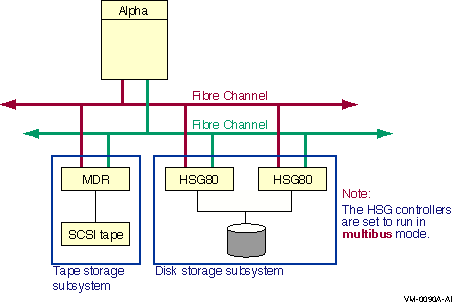
Note the following about this configuration:
- Host has two adapters, each attached to a different bus.
- Each port on each HSGx or HSVx storage controller
is attached to a different interconnect.
- Each port on the Modular Data Router (MDR) or the Network Storage
Router (NSR) is attached to a different interconnect.
- Both storage controllers can access the same disk.
- Host has four paths to the same logical unit.
Note that each HSG80 port has its own Fibre Channel address and Fibre
Channel port WWID. This is different from an HSZ80 in multibus mode
where all the ports respond to the same SCSI address and must,
therefore, be connected to different SCSI buses. The separate FC
addresses enable both ports of the dual HSG80 to be on the same FC.
Figure 6-17 is similar to Figure 6-16, except it has two additional
Fibre Channel interconnects.
Figure 6-17 Single Host With Two Dual-Ported Storage
Controllers, One Dual-Ported MDR, and Four Buses
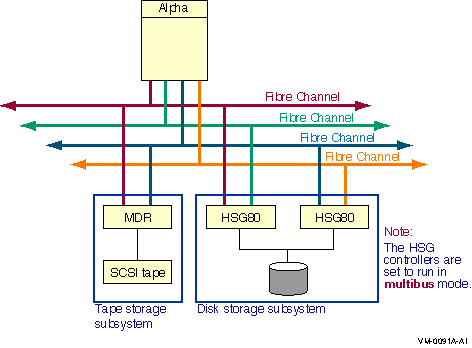
Note the following about this configuration:
- Host has four adapters, each attached to a different interconnect.
- Each port on each HSGx or HSVx storage controller
is attached to a different interconnect.
- Each port on the Modular Data Router (MDR) or the Network Storage
Router (NSR) is attached to a different interconnect.
- Host has four paths to the same logical unit.
Figure 6-18 builds on the previous two figures. Instead of a single
host, it has two hosts.
Figure 6-18 Two Hosts With Two Dual-Ported Storage Controllers,
One Dual-Ported MDR, and Four Buses
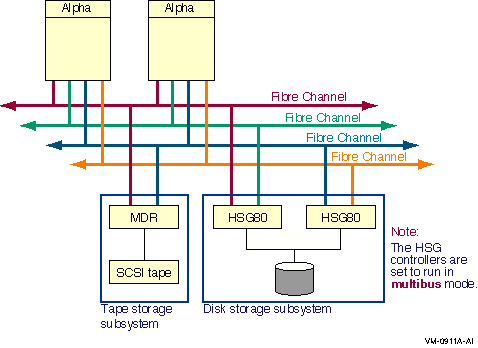
Note the following about this configuration:
- Each host has four adapters, each attached to a different
interconnect.
- Each port on each HSGx or HSVx storage controller
is attached to a different interconnect.
- Each port on the Modular Data Router (MDR) or the Network Storage
Router (NSR) is attached to a different interconnect.
- Each host has four paths to the same logical unit of the disk
storage subsystem and two paths to the tape storage subsystem.
6.7 Implementing Multipath Configurations
Parallel SCSI and Fibre Channel interconnects support multipath
configurations. Implementation of these configurations is similar, and
the system parameters and the command for specifying paths are the
same. The syntax for the path identifiers differs.
Implementing multiple paths to devices consists of the following steps:
- Configuring a system or systems with multiple physical paths to
those devices for which you want multipath support.
- Setting the HSx controller to multibus mode (disks only).
- Optionally qualifying multipath support by setting certain
multipath system and console parameters, as appropriate for your
configuration.
- Optionally tailoring the operation of multipath functionality,
using the DCL command SET
DEVICE/qualifier/PATH=path-identifier.
6.7.1 Valid Multipath Configurations
Figure 6-19 shows a valid multipath, multihost configuration.
Figure 6-19 Two Hosts With Shared Buses and Shared Storage
Controllers
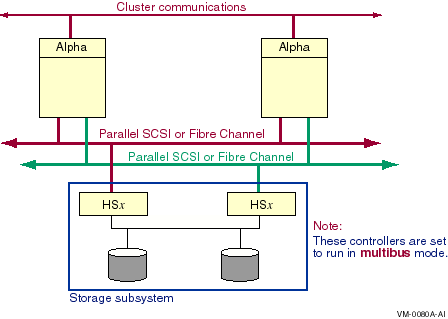
Note the following about this configuration:
- Each host has two adapters.
- Both hosts are connected to the same two buses.
- Both hosts share the storage.
- Each storage controller is connected to one bus only.
- The two storage controllers are connected to the same disks.
This configuration provides each host with two direct paths and one
MSCP served path to each device.
Figure 6-20 shows a valid multipath configuration for systems that
are not configured on the same bus.
Figure 6-20 Two Hosts With Shared, Multiported Storage
Controllers
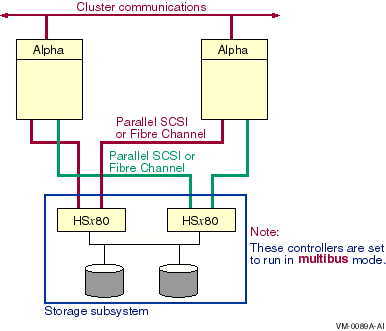
Note the following about this configuration:
- Each host has two adapters.
- Each host is connected to two buses but the hosts do not share a
bus.
- Both hosts share the storage.
- Each storage controller has two connections, one to each host.
- The two storage controllers are connected to the same disks.
This configuration provides each host with two direct paths, one to
each storage controller, and one MSCP served path to each device.
Figure 6-21 shows an invalid multipath configuration. The
configuration is invalid because, if multiple hosts in a cluster are
connected to an HSZ or HSG, they must all have connections to the same
controller modules (see Table 6-1). In this configuration, each
host is connected to a different controller module.
Figure 6-21 Invalid Multipath Configuration
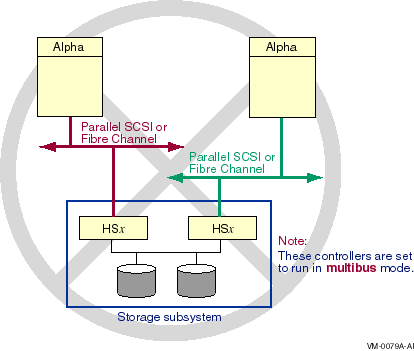
6.7.3 Multipath System Parameters
Multipath support is enabled and qualified by the use of the system
parameters described in Table 6-3. (Certain multipath system
parameters are reserved for the operating system.)
Table 6-3 Multipath System Parameters
| Parameter |
Description |
|
MPDEV_ENABLE
|
Enables the formation of multipath sets when set to ON (1). When set to
OFF (0), the formation of additional multipath sets and the addition of
new paths to existing multipath sets is disabled. However, existing
multipath sets remain in effect. The default is ON.
MPDEV_REMOTE and MPDEV_AFB_INTVL have no effect when MPDEV_ENABLE
is set to OFF.
|
|
MPDEV_LCRETRIES
|
Controls the number of times the system retries direct paths to the
controller that the logical unit is on line to, before moving on to
direct paths to the other controller, or to an MSCP served path to the
device (MSCP paths apply only to disks). The valid range for retries is
1 through 256. The default is 1.
|
|
MPDEV_POLLER
|
Enables polling of the paths to multipath set members when set to ON
(1). Polling allows early detection of errors on inactive paths. If a
path becomes unavailable or returns to service, the system manager is
notified with an OPCOM message. When set to OFF (0), multipath polling
is disabled. The default is ON. Note that this parameter must be set to
ON to use the automatic failback feature.
|
|
MPDEV_REMOTE (disks only)
|
Enables MSCP served paths to become members of a multipath set when set
to ON (1). When set to OFF (0), only local paths to a SCSI or Fibre
Channel device are used in the formation of additional multipath sets.
MPDEV_REMOTE is enabled by default. However, setting this parameter to
OFF has no effect on existing multipath sets that have remote paths.
To use multipath failover to a served path, MPDEV_REMOTE must be
enabled on all systems that have direct access to shared SCSI or Fibre
Channel devices. The first release to provide this feature is OpenVMS
Alpha Version 7.3--1. Therefore, all nodes on which MPDEV_REMOTE is
enabled must be running OpenVMS Alpha Version 7.3--1 (or later). If
MPDEV_ENABLE is set to OFF (0), the setting of MPDEV_REMOTE has no
effect because the addition of all new paths to multipath sets is
disabled. The default is ON.
|
|
MPDEV_AFB_INTVL (disks only)
|
Specifies the automatic failback interval in seconds. The automatic
failback interval is the minimum number of seconds that must elapse
before the system will attempt another failback from an MSCP path to a
direct path on the same device.
MPDEV_POLLER must be set to ON to enable automatic failback. You
can disable automatic failback without disabling the poller by setting
MPDEV_AFB_INTVL to 0. The default is 300 seconds.
|
|
MPDEV_D1
|
Reserved for use by the operating system.
|
|
MPDEV_D2
|
Reserved for use by the operating system.
|
|
MPDEV_D3
|
Reserved for use by the operating system.
|
|
MPDEV_D4
|
Reserved for use by the operating system.
|
6.7.4 Path Identifiers
The system management commands described in the following sections
allow you to monitor and control the operation of multipath failover.
These commands provide a path identifier to uniquely specify each path
in a multipath set.
Direct Fibre Channel paths are identified by the local host adapter
name and the remote Fibre Channel port WWID --- that is, the initiator
and the target. For example, in Figure 6-22, the path identifier for
the path from the host adapter on the left to the HSG storage
controller on the left is PGB0.5000-1FE1-0000-0201. (The second port on
each HSG is omitted for convenience.) You can obtain the WWID for a
storage controller from its console.
Figure 6-22 Fibre Channel Path Naming
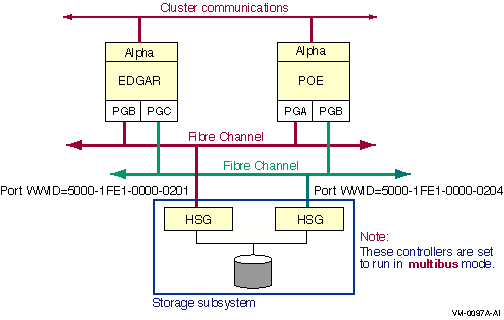
Direct parallel SCSI paths are identified by the local host adapter
name and the remote SCSI bus ID --- that is, the initiator and the
target. For example, in Figure 6-23, the path identifiers for node
Edgar's two direct paths to the disk would be named PKB0.5 and PKC0.5.
The path identifier for MSCP served paths is
MSCP
.
Figure 6-23 Configuration With Multiple Direct Paths
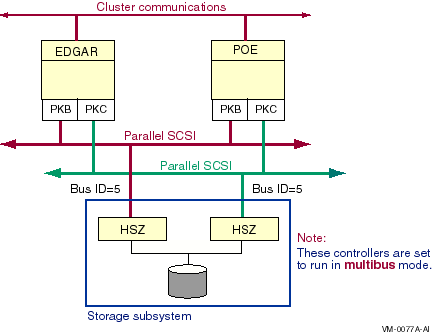
6.7.5 Displaying Paths
When multipath support is enabled, you can display the multiple paths
to a device using either of the following variants of the SHOW DEVICE
DCL command:
SHOW DEVICE/FULL device-name
SHOW DEVICE/MULTIPATH_SET device-name
|
The SHOW DEVICE/FULL device-name command displays the
traditional information about the device first and then lists all the
paths to a device by their path identifiers (described in
Section 6.7.4).
The SHOW DEVICE/MULTIPATH_SET device-name command lists only
some brief multipath information about devices that have multiple paths.
Multipath information is displayed only on nodes that are directly
connected to the multipath device.
The following example shows the output of a SHOW DEVICE/FULL
device-name command. Note that the use of multiple paths is
shown at the beginning of the display (
device has multiple I/O paths
), and the multiple path descriptions are shown toward the end of the
display, beneath
I/O paths to device
. Note, too, that the values for
Error count
and
Operations completed
shown at the beginning of the display are the sums of the counts for
each path.
$ SHOW DEVICE/FULL $1$DGA23:
Disk $1$DGA23: (WILD8), device type HSG80, is online, mounted, file-oriented
device, shareable, device has multiple I/O paths, served to cluster via MSCP
Server, error logging is enabled.
Error count 3 Operations completed 32814199
Owner process "" Owner UIC [SYSTEM]
Owner process ID 00000000 Dev Prot S:RWPL,O:RWPL,G:R,W
Reference count 9 Default buffer size 512
WWID 01000010:6000-1FE1-0000-0D10-0009-8090-0677-0034
Total blocks 17769177 Sectors per track 169
Total cylinders 5258 Tracks per cylinder 20
Host name "WILD8" Host type, avail Compaq AlphaServer GS160 6/731, yes
Alternate host name "W8GLX1" Alt. type, avail Compaq AlphaServer GS160 6/731, yes
Allocation class 1
Volume label "S5SH_V72_SSS" Relative volume number 0
Cluster size 18 Transaction count 8
Free blocks 12812004 Maximum files allowed 467609
Extend quantity 5 Mount count 8
Mount status System Cache name "_$1$DGA8:XQPCACHE"
Extent cache size 64 Maximum blocks in extent cache 1281200
File ID cache size 64 Blocks currently in extent cache 0
Quota cache size 0 Maximum buffers in FCP cache 1594
Volume owner UIC [1,1] Vol Prot S:RWCD,O:RWCD,G:RWCD,W:RWCD
Volume Status: ODS-2, subject to mount verification, file high-water marking,
write-back caching enabled.
Volume is also mounted on H2OFRD, FIBRE3, NORLMN, SISKO, BOOLA, FLAM10,
W8GLX1.
I/O paths to device 5
Path PGA0.5000-1FE1-0000-0D12 (WILD8), primary path.
Error count 2 Operations completed 130666
Path PGA0.5000-1FE1-0000-0D13 (WILD8), current path.
Error count 1 Operations completed 30879310
Path PGA0.5000-1FE1-0000-0D11 (WILD8).
Error count 0 Operations completed 130521
Path PGA0.5000-1FE1-0000-0D14 (WILD8).
Error count 0 Operations completed 130539
Path MSCP (W8GLX1).
Error count 0 Operations completed 1543163
|
For each path of the multipath device, the path identifier, the host
name associated with that path, the path status, the error count, and
the operations count are displayed.
The terms that may appear in the multiple paths portion of the display
are described in Table 6-4.
Table 6-4 SHOW DEVICE/FULL Multipath Terms
| Term |
Description |
|
WWID
|
The worldwide ID of the SCSI logical unit.
|
|
Host name
|
The name of the system that is being used by the current path. The host
name is displayed if there is an MSCP path to a multipath device.
|
|
Alternate host name
|
The name of another system that can also provide access to the device.
If the current path is a direct path, this will be the host currently
associated with the MSCP path. If the current path is an MSCP path,
this will be the name of the local system. The alternate host name is
displayed if there is an MSCP path to a multipath disk device.
|
|
Primary path
|
This was the first path to the device found by the operating system.
|
|
Current path
|
This path is currently used for I/O.
|
|
User disabled
|
The DCL command SET DEVICE/NOENABLE has been executed for this path.
|
|
Polling disabled
|
The DCL command SET DEVICE/NOPOLL has been executed for this path.
|
|
Not responding
|
This path to the device was unusable the last time it was checked.
Typically, the multipath poller checks every 60 seconds if the path is
good and every 30 seconds if the path is bad.
|
|
Unavailable
|
The path is unavailable because the software driver has disconnected
from the path.
|
6.7.5.2 Displaying Paths With SHOW DEVICE/MULTIPATH_SET
You can obtain a brief listing of multiple paths for a specific device,
for all the devices in an allocation class, or for all devices with the
DCL command:
SHOW DEVICE/MULTIPATH_SET [device-name]
|
The device name is optional; when omitted, all devices that have formed
multipath sets are shown. For each multipath device found, the device
name, host name, device status, error count, number of accessible
paths, total number of paths, and the current path's path identifier
are displayed.
The number of accessible paths can be less than the total number of
paths for two reasons:
- A system manager disabled the path with the command SET
DEVICE/PATH=pathname/NOENABLE.
- If a path is designated as Not Responding, the operating system
decrements the total number of paths. This action was introduced in
OpenVMS Alpha Version 7.3--1.
The host name displayed is the host name of the current path. For
direct paths, this will be the local system's host name. For MSCP
served paths, this will be the host name of the remote system which is
serving access to the device.
The following example shows the output of a SHOW DEVICE/MULTIPATH
command.
$ SHOW DEVICE/MULTIPATH
Device Device Error Paths Current
Name Status Count Avl/Tot path
$1$DGA8: (H2OFRD) Mounted 3 5/ 5 PGA0.5000-1FE1-0000-0D12
$1$DGA10: (H2OFRD) ShadowSetMember 1 5/ 5 PGA0.5000-1FE1-0000-0D14
$1$DGA11: (WILD8) ShadowSetMember 3 3/ 3 MSCP
$1$DGA23: (H2OFRD) Mounted 6 5/ 5 PGA0.5000-1FE1-0000-0D13
$1$DGA30: (H2OFRD) ShadowSetMember 8 5/ 5 PGA0.5000-1FE1-0000-0D13
$1$DGA31: (WILD8) ShadowMergeMbr 5 3/ 3 MSCP
$1$DGA33: (H2OFRD) Online 0 5/ 5 PGA0.5000-1FE1-0000-0D12
$1$DGA40: (H2OFRD) Mounted 2 5/ 5 PGA0.5000-1FE1-0000-0D13
$1$DGA41: (H2OFRD) ShadowMergeMbr 8 5/ 5 PGA0.5000-1FE1-0000-0D12
$70$DKA100: (H2OFRD) Mounted 0 3/ 3 PKD0.1
$70$DKA104: (H2OFRD) ShadowSetMember 0 3/ 3 PKD0.1
$70$DKA200: (H2OFRD) ShadowSetMember 0 3/ 3 PKD0.2
$70$DKA300: (H2OFRD) ShadowSetMember 0 3/ 3 PKC0.3
$80$DKA1104: (H2OFRD) ShadowSetMember 0 3/ 3 PKD0.11
$80$DKA1200: (H2OFRD) ShadowSetMember 0 3/ 3 PKD0.12
$80$DKA1204: (H2OFRD) ShadowSetMember 0 3/ 3 PKC0.12
$80$DKA1207: (H2OFRD) Mounted 0 3/ 3 PKD0.12
$80$DKA1300: (H2OFRD) Mounted 0 3/ 3 PKD0.13
$80$DKA1307: (H2OFRD) ShadowSetMember 0 3/ 3 PKD0.13
$80$DKA1500: (H2OFRD) Mounted 0 3/ 3 PKD0.15
$80$DKA1502: (H2OFRD) ShadowSetMember 0 3/ 3 PKD0.15
|
If you choose to specify a partial device name, such as $70$DKA, the
display shows all devices with multiple paths whose names begin with
$70$DKA.
|








